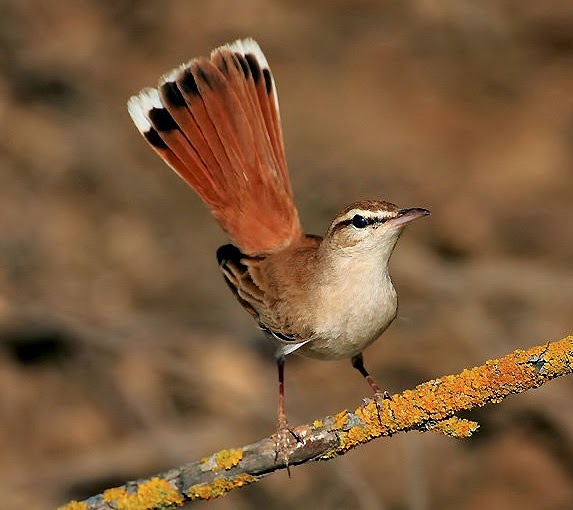 |
| Photo by Yoram Shpirer (Oiseaux) |
Common name:
rufous-tailed scrub-robin (en); rouxinol-do-mato (pt); agrobate roux (fr); alzacola (es); heckensänger (de)
Taxonomy:
Order Passeriformes
Family Muscicapidae
Range:
This species breeds in southern Europe, in the southern Iberian Peninsula, and from the Balkans to Turkey, also in North Africa from Morocco to Egypt, and in western Asia, through the Middle East and into Pakistan and Kazakhstan. They migrate south to winter along the Sahel belt and through Ethiopia down to Kenya and northern Tanzania. Some populations in the Sahel are resident.
Size:
These birds are 14-17 cm long and have a wingspan of 22-27 cm. They weigh 18-26 g.
Habitat:
The rufous-tailed scrub-robin is mostly found in dry scrublands, especially along seasonal creeks and streams, but also use dry savannas and grasslands, dry tropical forests, plantations, arable land, rural gardens and even urban areas. They are present from sea level up to an altitude of 1.500 m.
Diet:
They mainly hunt insects and earthworms, but also other invertebrates. Their prey includes ants, grasshoppers, crickets, spiders and butterflies.
Breeding:
Rufous-tailed scrub-robins breed in May-July. The female is mostly responsible for building the nest, a loose structure made of fine twigs, grasses, roots and plant fibres, and lined with plant down, wool, hair and feathers. It is placed in a thick scrub or small tree, usually within 1 m of the ground. The female lays 3-6 pale greenish or greyish-white eggs with greyish-brown spots, which she incubates alone for 13-14 days. The chicks are fed by both parents and fledge 13-16 days after hatching.
Conservation:
IUCN status – LC (Least Concern)
This species has a very large breeding range and the global population is estimated at 196.000-1.150.000 individuals. The population is suspected to be stable in the absence of evidence for any declines or substantial threats.







